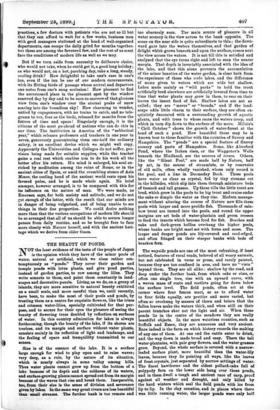THE BEAUTY OF PONDS.
NOT the least evidence of the taste of the people of Japan is the opinion which they have of the minor pools of water, natural or artificial, which we class rather con- temptuously as "ponds." They cover their garden and temple ponds with lotus plants, and give pond parties, instead of garden parties, to row among the lilies. They write sonnets to them, and paint them constantly in land- scapes and decorative panels. Living, as we do, on a group of islands, they are more sensitive to natural beauty exhibited on a small scale, and more careful than we, until recently, have been, to make the most of their pools and ponds, by treating them as a centre for exquisite flowers, like the irises and crimson water-lilies, specially cultivated for that pur- pose, and to secure for their eyes the pleasure of seeing the beauty of flowering trees doubled by reflection on surfaces of water. In this country admiration for lakes is always forthcoming, though the beauty of the lake, if its shores are treeless, and its margin and surface without water plants, consists mainly in its reflection of light and landscape, and the feeling of space and tranquillity transmitted to our senses.
Size is of the essence of the lake. It is a surface large enough for wind to play upon and to raise waves; very deep, as a rule, by the nature of its situation, which is nearly always in some valley among hills. Thus water plants cannot grow up from the bottom of a lake because of its depth and the coldness of its waters, and surface-growing plants cannot spread out from its margin because of the waves that rise and, break them. Inseparable, too, from their size is the sense of division and severance given by lakes. In the same way great rivers are less beautiful than small streams. The further bank is too remote and too obscurely seen. The main source of pleasure in all water scenery is the view across to the bank opposite. The scene on the near side is quite subordinate to this ; the down- ward gaze into the waters themselves, and that garden of delight which grows beneath and upon the surface, comes next the view across the waters. It is not till this is satisfied and analysed that the eye turns right and left to scan the nearer margin. That depth is invariably associated with the idea of the lake, and that this alone prevents the accumulation of the minor beauties of the water garden, is clear both from
the experience of those who make lakes, and the difference
of name given to waters which are wide but shallow. Lakes made mainly as "wild parks" to hold the trout artificially bred elsewhere are artificially lowered from time to time that water plants may grow in them, to rear on their leaves the insect food of fish. Shallow lakes are not so called ; they are " meres" or "broads," and if the land- scape adds little eharm to their surface, they are often ex- quisitely decorated with a surrounding growth of aquatic plants, and with trees to whose roots the waters creep, and which in turn dip down to the surface of the mere. Millais's Chill October " shows the growth of water-forest at the head of such a pond. How beautiful these may be is known best to those familiar with the counties of Surrey and Hampshire. The " ponds " are a special feature of Surrey scenery and parts of Hampshire. Some, like Alresford Pond, where the Itchen rises, or the Waggoner's Wells beneath the Hindhead, are the sources of rivers. Others, like the " Silent Pool," are made half by Nature, half by art, in the course of streamlets, or by reservoirs of old mills, often wholly vanished, whose only record is the pool, and a line in Doomsday Book. These pools have water as clear as crystal, fed by tiny streams cut in the hillsides, which slip into them through miniature beds of tussock and tall grasses. Up these rills the little trout are bred, which grow in the pools to be big trout and cruise under the oaks or dimple the water as they rise. Modern manage- ment without altering the course of Nature now fills these pools with larger and more prolific fish. Thousands of rain- bow trout are turned into the pools, and round the upper margins are set beds of water-plantain and green cresses to feed the insects which become food for fish. Beeches and oaks and dark-green hollies overhang the higher pools, whose banks are bright marl set with ferns and moss. The larger and deeper ponds are lily-covered and reed-edged, and often fringed on their steeper banks with beds of bracken -fern.
The wayside ponds are one of the most refreshing, if least noticed, features of rural roads, beloved of all weary animals, bat not celebrated in verse or prose, and rarely painted, because they are too confined in area, and have no " vista " beyond them. They are all alike : shallow by the road, and deep under the further bank, from which oaks or elms, or often one single tree, rise with an upward curve, with a woven mass of roots and rootlets going far down below the surface level. The field ponds, often set at the corner where four fences meet, so as to afford water to four fields equally, are prettier and more varied, but often so overhung by masses of thorn and briars that the fallen leaves make the waters thick, and when still on their parent branches shut out the light and air. When these ponds lie in the centre of the meadows they are really beautiful objects. In the more waterless counties, such as Suffolk and Essex, they are numerous and very ancient. Rare indeed is the farm on which history records the making of any one of them. At one end the cattle enter to drink, and the way down is made broad and easy. There the tall water-plantains, with pale grey flowers, and the water grasses grow. Beyond, the whole surface is covered with a narrow- leafed surface plant, more beautiful than the water-lily leaves, because they lie pointing all ways, like the leaves of frost crystals, just separated by narrow settings of water. The finest hawthorns and the oldest pollard-oaks full of polypody fern on the lower side hang over these ponds, and in them dwell a tough and ancient race of carp, proof against all weather and drought, and only killed by the hard winters which seal the field ponds with ice from lip to lip. In the clay counties, and in places where there was little running water, the larger ponds were only half
left to Nature. They were dug for fish - pools, or purely for ornament, though the fish were mainly carp and tench, and not the good trout of the Southern pools. The grass is still kept smooth upon their banks, and the sides of the pools are planted with the trees in fashion eighty years ago. The quince was the favourite pondside tree of our ancestors. It grows best by the water, and from spring, when the pink blossom and grey leaves cover the drooping branches, till late in autumn, when the golden fruits dropped into the pool, and were gathered thence after a week's bath, which was believed to improve their flavour, the tree was always . an ornament to the margin. Laburnum, weeping willow, and the ilex were the other trees planted by the garden pools in the end of the eighteenth and the early nineteenth century. The pond- garden, with flowers and plants, is of recent growth in England. Now it is often among the brightest features of the half-wild garden, and even close to the smooth lawns and terraces. The surface of the water is covered with crimson, pink, and sulphur-yellow water-lilies. Exquisite Japanese irises fringe the pool in spring, and bunches of daffodils and narcissus, which always grow best where they are mirrored in the water.
If the pool is deep the exotic water-lilies do not feel the frost, while there are numbers of lovely hardy plants which will brighten its borders for the mere trouble of planting them. Frogs and duckweed were often the main produce of such pools in the days of our grandfathers. Now brilliant flowers and scarcely less beautiful fish are inseparable from them. Wherever there is a slight entering stream and overflow from the pond, or springs riding in it which find their way out in the smallest trickle of water, it may be stocked with the trout bred in hundreds of thousands in the many fish hatcheries now established in this country. The fish, yearlings or two-year-olds, brown trout or the beautiful rain- bow trout, are delivered at the nearest station without risk. Water insects to "sow" the pool with are sent with the fish, which are also fed with special "fish-meal." They come hungry, for they have been starved for a fortnight at the fishery to get them into travelling condition. The writer recently saw a pond in grounds close to the Thames which had been stocked a year ago with five hundred trout about four inches long. They are now all fine fish of from lb. to I lb. in weight, and give life and movement to the pond, whose sur- face is broken in an instant with flashing sides and shining tails, as the food is thrown in to the eager and voracious trout now living where formerly a few eels and muddy tench lay invisible upon the bottom.



































 Previous page
Previous page